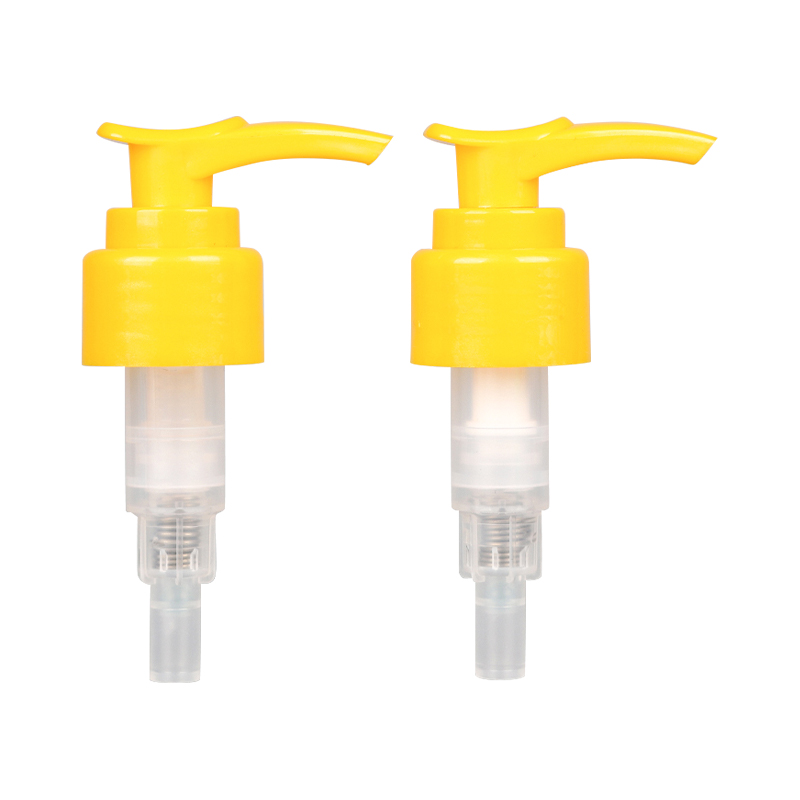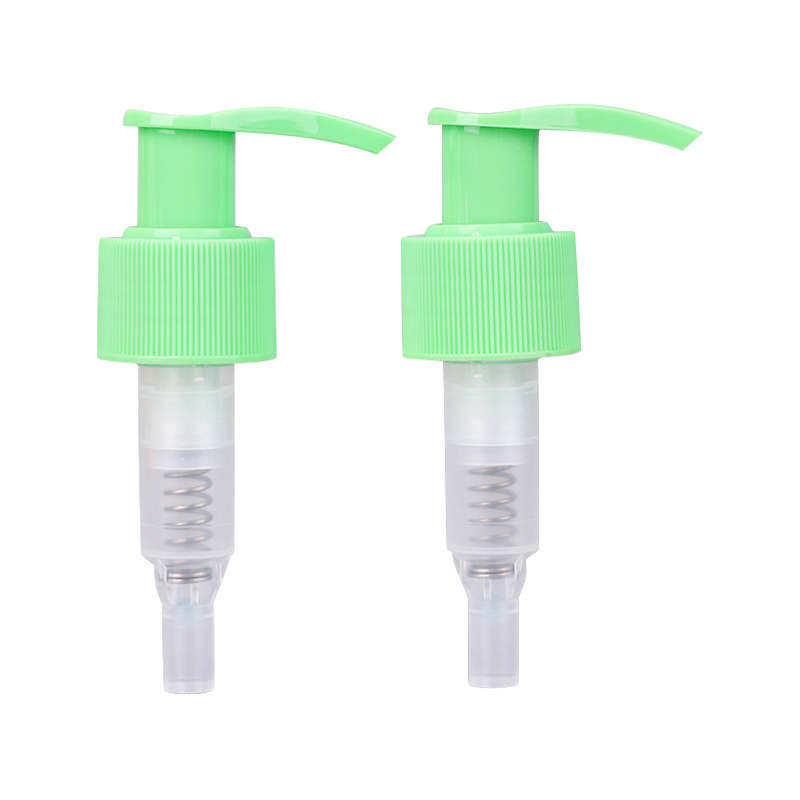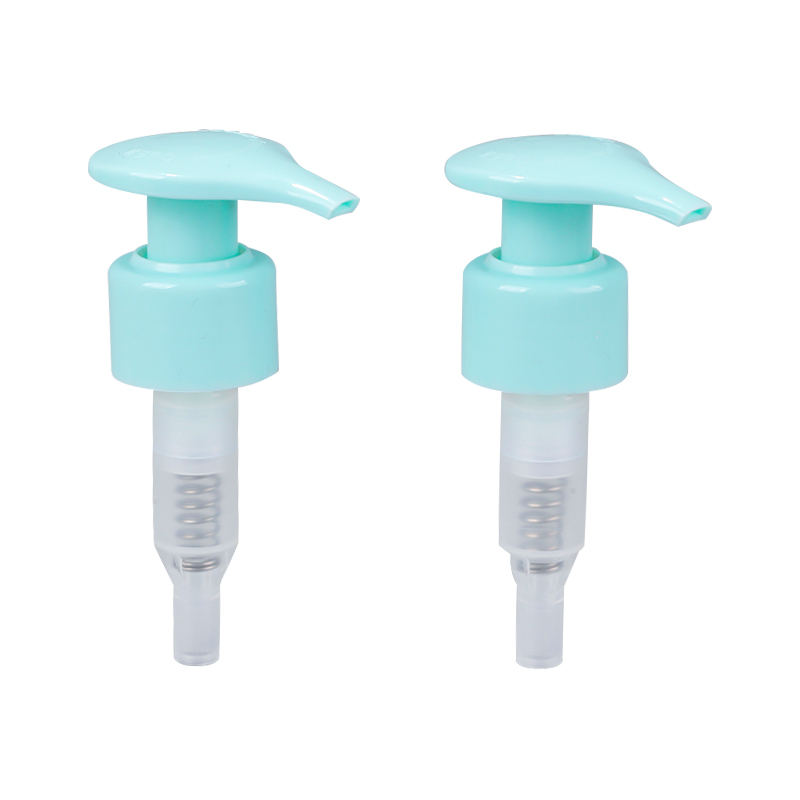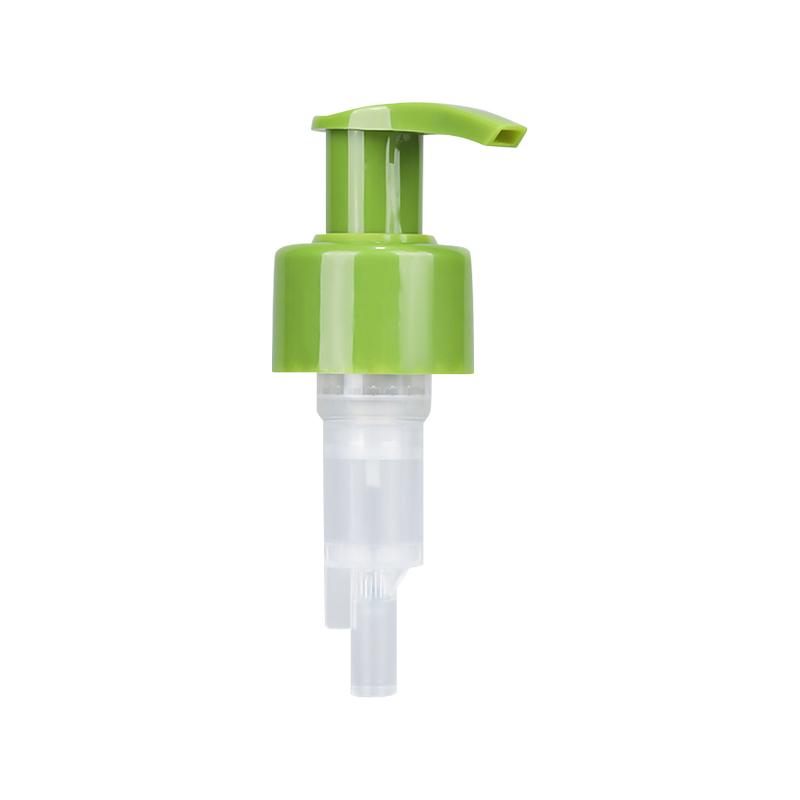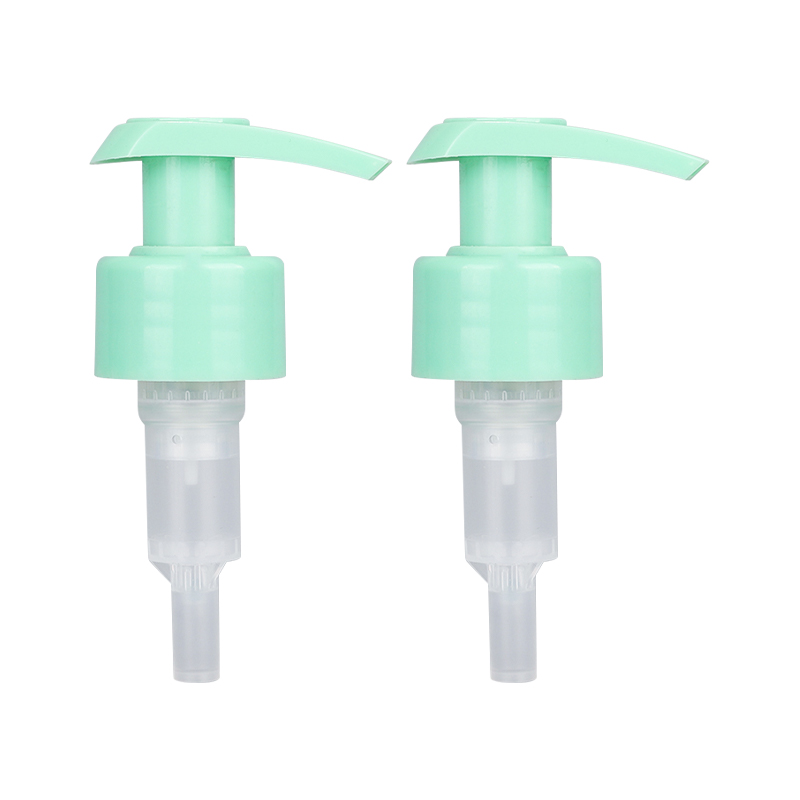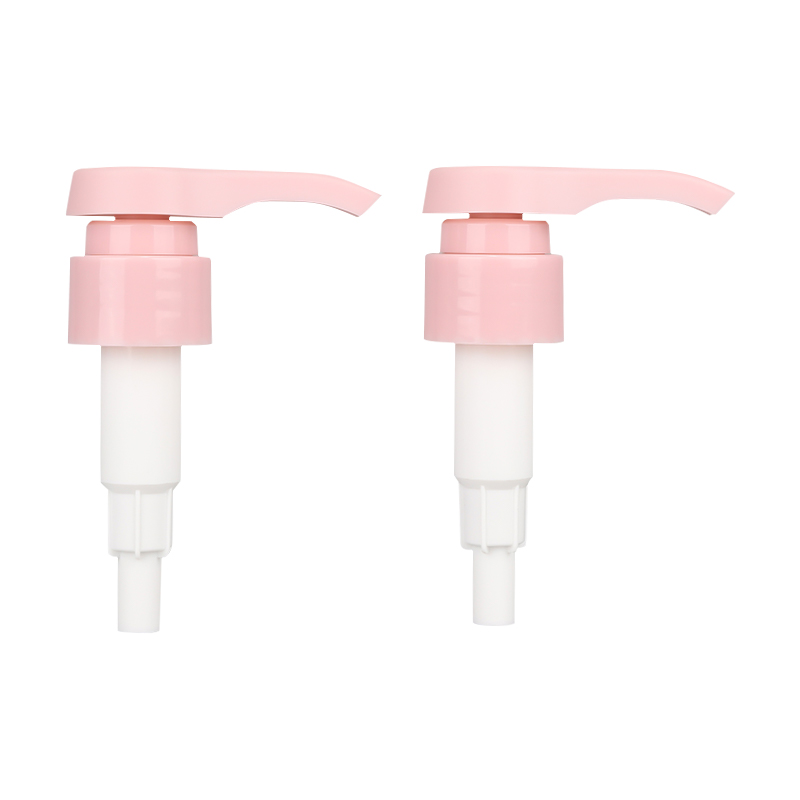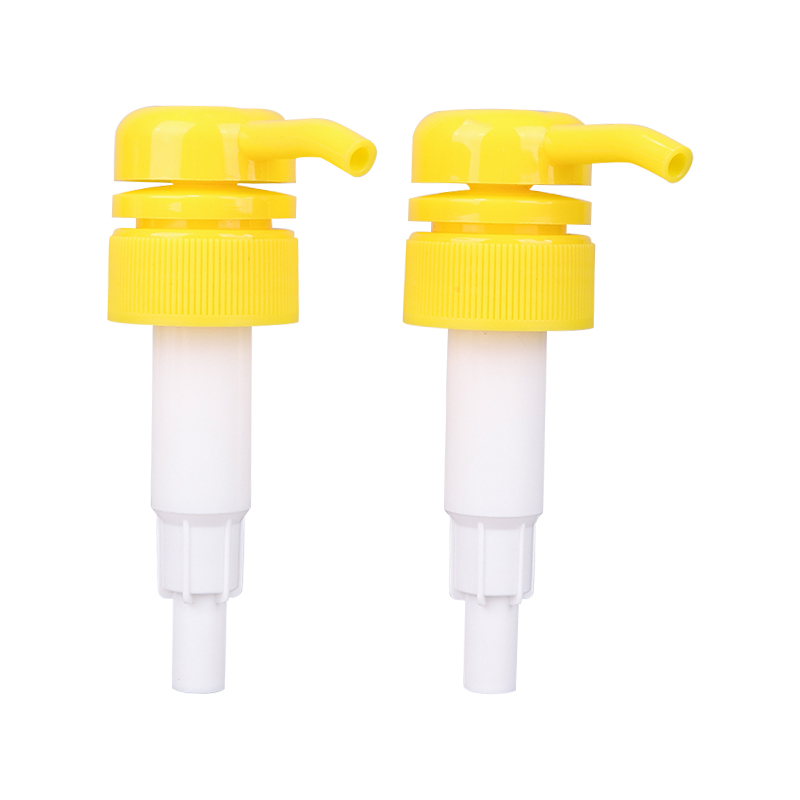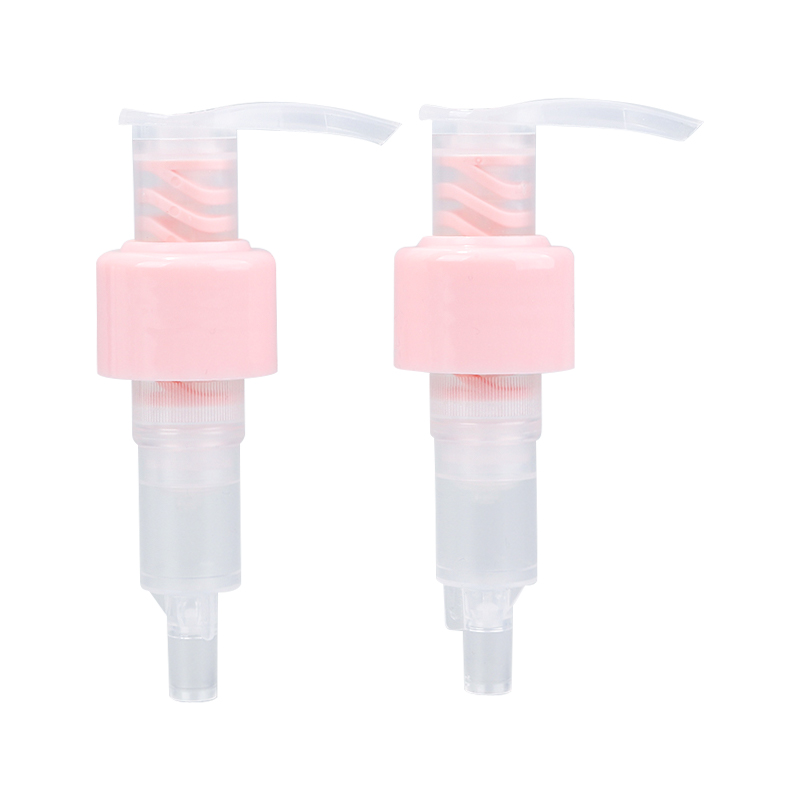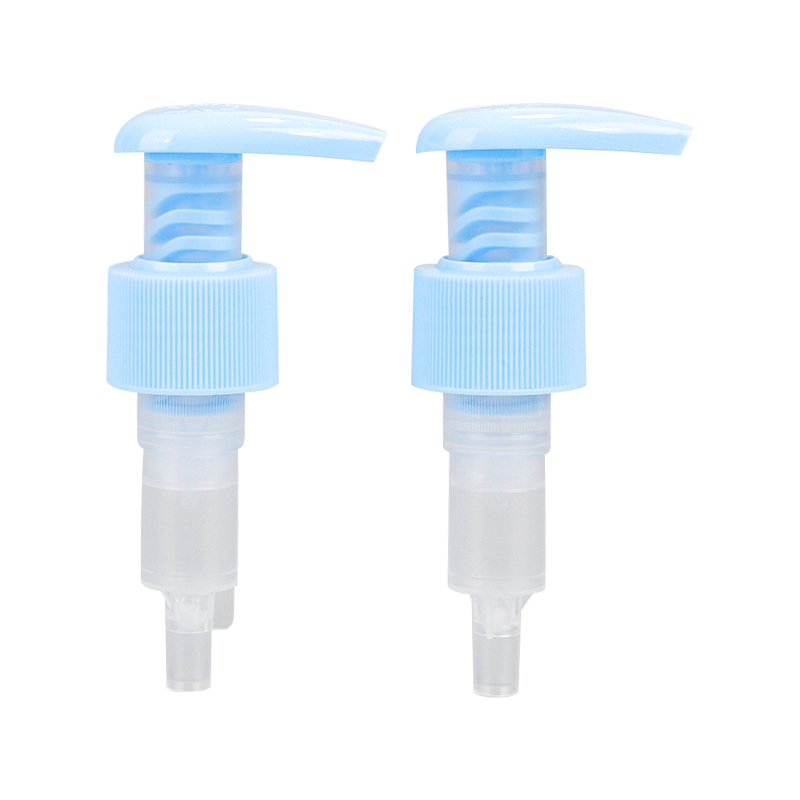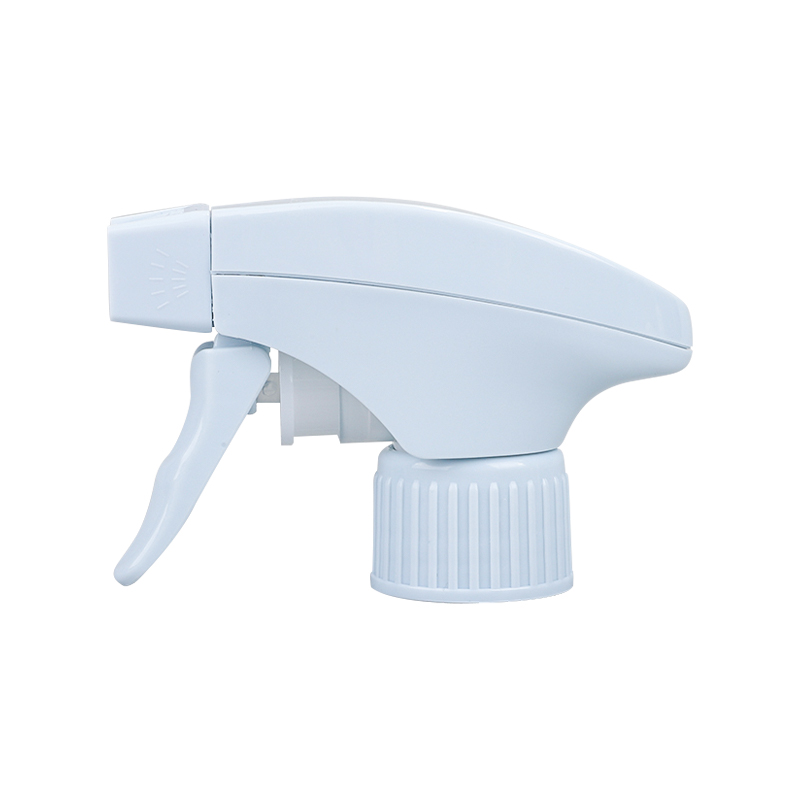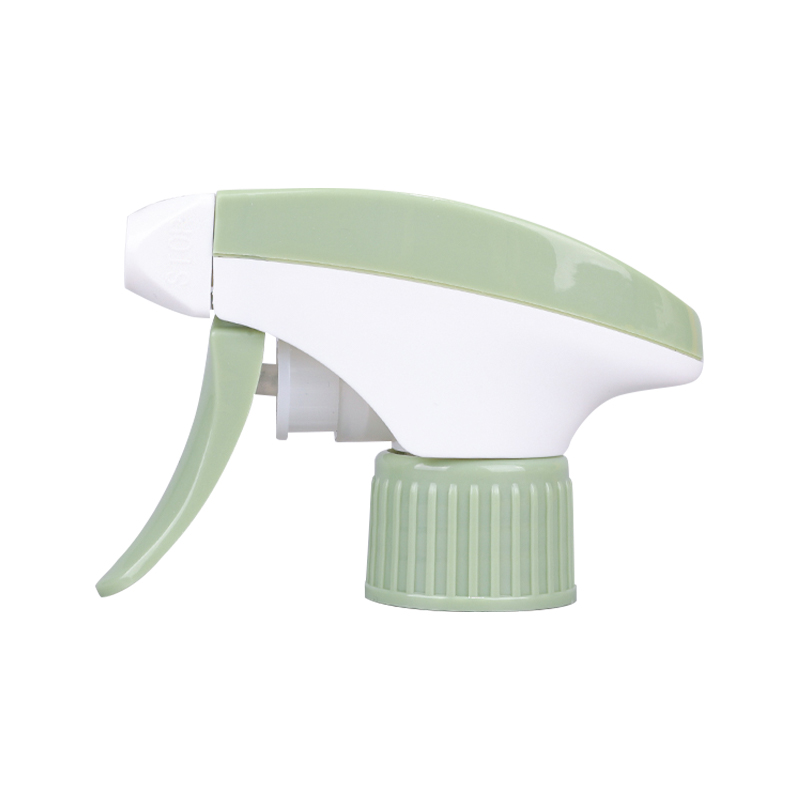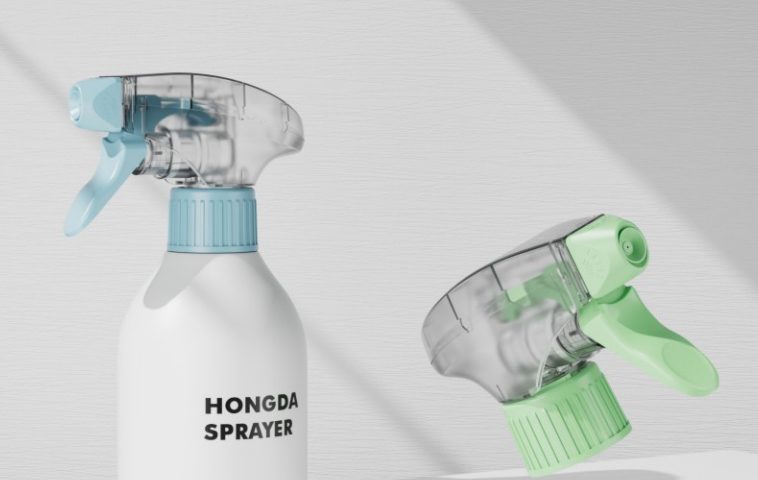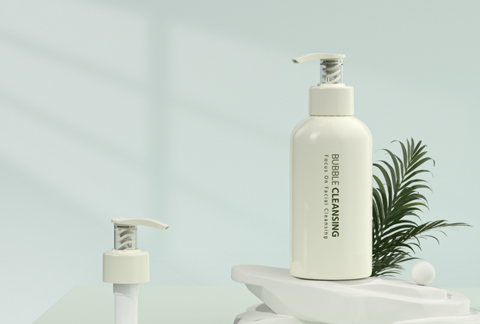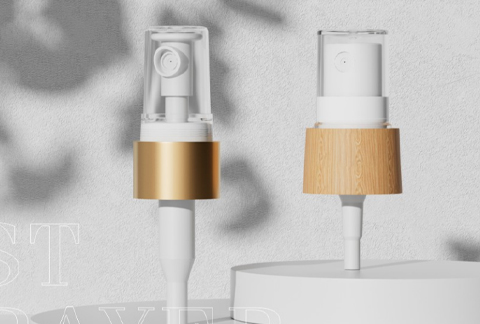What is a trigger sprayer? Introduction to functions and structure
Definition and basic overview
A trigger sprayer is a manual liquid spraying tool widely used in daily life and industrial scenarios. It sucks out the liquid in the container and sprays it out in the form of a spray by manually pressing the trigger device. Trigger sprayers are mainly used in combination with plastic bottles and are often used in the packaging and use of liquid products such as detergents, gardening agents, disinfectants, and cosmetics.
Due to its easy operation and strong controllability, this device has become one of the common liquid spraying solutions in the fields of home, office, agriculture and light industry.
Main structural components of trigger sprayers
The trigger sprayer looks simple, but its internal structure contains multiple tightly matched parts. It is mainly composed of the following parts:
Trigger: The operating part where the user applies hand pressure, which is the starting switch of the entire device.
Piston and spring assembly: Responsible for converting the mechanical energy of the trigger into pressure, and extracting the liquid from the bottle through suction.
Dip Tube: Extends to the bottom of the bottle and is used to extract liquid.
Valve system (usually including inlet valve and outlet valve): controls the one-way flow of liquid to prevent backflow.
Nozzle: used to atomize liquid into different forms of spraying effects, adjustable or fixed.
These parts are assembled by plastic injection molding, which is light, economical and easy to mass produce.
Working principle analysis
The basic working principle of the trigger sprayer is negative pressure suction and gas-liquid mixed atomization. During operation, the user presses the trigger, the piston moves forward and compresses the air inside the pump chamber, increasing the pressure. When the trigger is released, the spring pushes the piston to reset, forming negative pressure, and sucking the liquid from the straw into the pump chamber. Then the next press, the liquid is pushed to the nozzle, sprayed out through the nozzle and forms a fine mist. This intermittent spray mechanism can effectively control the dosage of each spray and achieve targeted liquid release.
Common functional design and expansion
In order to adapt to different application scenarios, the design of modern trigger sprayers has been gradually refined, covering multiple functional features, including:
Adjustable spray mode: Some nozzles can adjust the spraying form by rotation, such as mist, column, spot spray, etc.
Lock function: Some sprayers are equipped with safety locks to prevent accidental spraying or misuse by children.
Leak-proof structure: Through reasonable cooperation with sealing rings, liquid leakage during transportation and storage is reduced.
Corrosion-resistant materials: For acidic or alkaline liquids, some components will use materials such as reinforced plastics or stainless steel springs.
These designs improve its practicality in many fields such as home cleaning, medical protection, and agricultural plant protection.
Material selection and environmental considerations
The main material of the trigger sprayer is plastic, and common materials include polypropylene (PP), polyethylene (PE) and polyethylene terephthalate (PET), etc. These materials have the characteristics of strong formability and good chemical stability. Stainless steel or rubber materials may be used for springs, sealing rings and other parts.
In recent years, for environmental protection and recyclability considerations, some manufacturers have begun to use recycled plastics or bio-based plastics, while optimizing structural design, reducing plastic usage, and achieving lightweight packaging.
Widely distributed application scenarios
The application range of trigger sprayers spans multiple daily and professional fields, and the typical scenarios are as follows:
Home cleaning: conventional packaging forms of liquid cleaners such as kitchen degreasing and bathroom descaling.
Gardening spraying: used for watering, pesticide spraying, plant maintenance and other operations.
Car care: used for spraying glass water, tire cleaner, etc.
Beauty care: some packaging forms of hair care water and lotion use a small trigger structure.
Public epidemic prevention: Disinfectant spraying equipment, especially widely used during the epidemic period.
Industrial use: portable spraying of lubricants, release agents, etc.
Due to its convenience and controllability, trigger sprayers can flexibly adapt to different liquid viscosities and dosage requirements.
Comparison with other sprayers
In liquid spraying equipment, trigger sprayers are often compared with air pressure sprayers, pump sprayers, aerosol cans and other forms:
Compared with air pressure sprayers: no need to pre-charge, the operation is more direct, but the spray range and duration are limited.
Compared with aerosol cans: no propellant is contained, environmental protection and safety are better, but the atomization uniformity is slightly inferior.
Compared with pump sprayers: the structure is more compact and suitable for portable use scenarios.
The trigger sprayer finds a good balance between convenience and cost control, so it is more common in retail packaging and portable products.
Maintenance and use precautions
Although the trigger sprayer has a simple structure, the following precautions should still be taken in daily use to maintain its service life and spray effect:
Avoid long-term retention of highly corrosive liquids, and rinse with clean water after use.
Prevent falling or external force extrusion to avoid deformation of the internal structure.
Check the nozzle regularly for blockage, which can be cleaned with warm water or a soft brush.
Close the nozzle or use the leak-proof mode during storage to reduce volatilization or leakage.
Standardized use can effectively extend the life cycle of the sprayer and reduce the frequency of replacement.
Market trends and future development directions
With the increasing requirements for user experience and green environmental protection, trigger sprayers are developing in the following directions:
Lightweight structure and energy-saving materials: reduce the amount of plastic through process optimization and increase recycling value.
Functional modular design: achieve rapid adaptation between different liquids and spray requirements.
Intelligent spray control: Some high-end products try to combine electronic components to achieve quantitative spraying.
Replaceable nozzle and bottle design: increase the reuse rate and meet the concept of sustainable consumption.
These trends show that trigger sprayers not only meet the current market demand, but also have the potential to adapt to future green consumption and intelligent manufacturing transformation.
Common uses and applicable scenarios of trigger sprayers
Application in the field of household cleaning
Trigger sprayers are widely used in the home environment and are one of the common cleaning tool accessories. It is mainly used for local spraying with various cleaning liquids to remove common pollutants such as oil stains, scale, stains, etc.
Kitchen detergents are mostly packaged in trigger sprays, which is convenient for users to wipe after spraying detergent on stoves, sinks and walls, saving dosage and improving efficiency. In bathrooms, living rooms, glass windows, tile walls and other places, spray cleaning products containing disinfecting ingredients or decontamination ingredients are also common, and sprayers can achieve more uniform coverage. Some multi-functional household care liquids, such as air fresheners and fabric deodorizing sprays, also tend to use trigger spray heads to improve coverage efficiency and control flexibility during use.
Role in horticultural and agricultural spraying
Trigger sprayers are also a common tool in horticultural care and home cultivation. It is suitable for daily watering, spraying water, fertilization and pest control of plants.
Due to its convenient operation and easy control of the spraying range, users can provide differentiated care for different types of plants. For example, for delicate plants or potted flowers, the sprayer can provide a finer mist to avoid damage to petals or leaves caused by water column impact. In small-area agricultural applications, trigger sprayers can also be used to spray low doses of pesticides, fungicides or nutrient solutions, especially suitable for test fields, small greenhouses or home balcony planting.
Use in car beauty and maintenance
Trigger sprayers are very common in car maintenance products, especially when used with liquid products such as glass water, interior cleaners, and body care agents.
During vehicle cleaning, the sprayer can quickly and evenly spray the detergent on different parts such as windows, dashboards, and wheels, which helps to improve cleaning efficiency and reduce liquid waste. Some professional car beauty products (such as tar removers and shellac cleaners) usually require precise spraying, and sprayers can provide more precise spraying control. Due to its portability and simple operation, many car owners will keep the care solution with a trigger sprayer in the car for easy handling at any time.
Medical and health protection scenarios
In medical institutions and public health protection situations, trigger sprayers are often used in combination with disinfectants or cleaning fluids for spraying and sterilizing surfaces or air.
For example, in public places such as hospitals, clinics, schools, offices, and stations, cleaning staff can use sprayers to regularly disinfect door handles, desktops, equipment housings, floors, and other areas. Especially during periods of frequent public health events, the demand for portable disinfectant products equipped with trigger sprayers has grown rapidly.
Medical uses also include preliminary spraying before cleaning instruments and cleaning the patient's surrounding environment. Spraying can reduce contact risks and improve treatment efficiency.
Practices in personal care and beauty
Some cosmetics and skin care products also use trigger sprayers as packaging structures to control dosage and improve comfort. Common products include makeup setting sprays, hair sprays, body care water, hydrating sprays, and more.
Compared with pressing pumps or aerosols, the trigger structure is more conducive to users adjusting the frequency and coverage of use according to their needs, and is particularly suitable for non-continuous skin care scenarios. In addition, the spray structure can also be applied without direct contact with the hands, improving the sense of hygiene.
Some homemade skin care products, such as aromatherapy essential oil mixtures and floral water, also often use small trigger spray bottles as containers.
Local spraying operations in industrial manufacturing
In some light industrial manufacturing fields, trigger sprayers are often used for manual spraying operations of cleaning agents, release agents, rust inhibitors, lubricants, etc. It is suitable for scenes such as equipment cleaning, mold surface treatment, and preliminary decontamination of parts at workstations.
Compared with automatic spraying equipment, manual sprayers are simple to operate and easy to carry, especially suitable for intermittent operations or use environments with unfixed positions. In addition, its controllability also gives it certain advantages in detail processing, such as pre-treatment of fine parts. Some workplaces even equip employees with multiple sprayers to distinguish between liquid types to avoid cross contamination.
Commercial retail and portable packaging scenarios
Trigger sprayers are also a widely used packaging form in many commercial brand products, especially for liquid products that need to be portable or manually controlled. Due to its relatively low cost and intuitive use, it has become a regular choice for many fast-moving consumer goods.
Typical examples include window cleaning fluid, desktop cleaner, pet deodorizing spray, portable insecticide spray, sports equipment sterilization spray, etc. Such products are usually targeted at specific needs, and have different settings in terms of capacity design, nozzle caliber, trigger damping feeling, etc. Retailers can also easily distinguish different products by changing labels or nozzle colors to improve consumer experience.
Application in educational and experimental environments
In educational environments such as schools, laboratories, and training centers, trigger sprayers can be used for model display, experimental demonstration, and material pretreatment.
For example, in chemical experiments, it is used to spray alcohol, deionized water, or specific solvents for equipment pretreatment; in biological experiments, it is often used to spray nutrient solution or disinfectant to maintain sterile conditions; in physical demonstrations, it may also be used to demonstrate basic concepts such as liquid behavior and surface tension.
Educational scenarios have certain requirements for the material stability and atomization uniformity of the sprayer, so neutral materials and non-volatile plastic parts are often used.
Daily use in pet care
In pet care, trigger sprayers are becoming more popular and are used to spray pet cleaning liquids, insect repellents, hair care liquids, and deodorant liquids.
For dogs, cats, and small rodents, using sprays can reduce the discomfort of direct contact with liquids and facilitate local treatment, such as ear disinfection and paw cleaning. Pet stores, pet hospitals, and home breeders often have such products for daily care or training assistance. Some sprayers are designed with low-noise nozzles to reduce the fright of pets and improve their cooperation.
The role of environmental protection and sustainable packaging exploration
With the promotion of the concept of green packaging, trigger sprayers are gradually entering the recyclable system. Some brands have begun to launch replaceable bottles or multiple filling designs to encourage users to reduce the waste of disposable containers.
This type of packaging is particularly suitable for supporting reusable liquid products such as household cleaning, gardening care, and air fresheners. By replacing liquid refills or repeatedly cleaning and using bottles, plastic usage and packaging waste can be reduced in daily consumption. Some recycled plastic materials are also gradually introduced into the manufacture of sprayers, promoting their entry into the environmentally friendly daily packaging system.
Key points for the application of trigger sprayers in commercial and industrial environments
Basic structure and function of trigger sprayer
As a manually controlled spraying tool, trigger sprayer usually consists of a bottle, a nozzle and a trigger. The bottle is mainly used to store liquid, the nozzle is responsible for adjusting the size and type of spray, and the trigger is used to push the liquid through the nozzle and spray it out. By compressing the trigger, the user can accurately control the amount and range of liquid spraying, which makes the sprayer widely used in scenarios where the amount of spraying needs to be precisely controlled.
This design makes the trigger sprayer very functional and applicable in commercial and industrial environments, especially in applications where liquids need to be handled efficiently.
Key points of application in commercial environments
In commercial environments, the use of trigger sprayers is mainly concentrated in the following aspects:
- Cleaning and maintenance
In retail stores, catering, hotels and other service industries, trigger sprayers are widely used for daily cleaning and maintenance. Liquid products such as detergents, disinfectants, and air fresheners are often packaged in trigger sprayers, which can quickly cover the target surface by spraying when used. Common application scenarios include:
Kitchens and restaurants: spraying oil cleaners and kitchen disinfectants to help clean high-contact areas such as countertops, stoves, and exhaust systems.
Office areas: spraying window cleaners, desktop disinfectants, or air fresheners to ensure a clean and comfortable office environment.
Shopping malls and retail stores: used to clean shelves and floors, spray air fresheners or disinfectant products, and keep the store environment clean and fresh.
The efficiency and convenience of sprayers enable these places to save time and cleaning costs, while also ensuring hygiene standards in daily work.
- Beauty and care
Trigger sprayers are also widely used in the beauty industry, especially in areas related to skin care and hair products. For example, lotions, moisturizing sprays, conditioners, makeup sprays, etc., many beauty products choose trigger sprays as packaging. They can help customers use these liquid products more conveniently, provide uniform spray coverage, and avoid overuse or waste.
Beauty salons and hair salons also often use trigger sprayers for deep care or repair care, which can easily achieve precise treatment of different parts, such as spraying essential oils, care solutions, etc.
- Product promotion and sales promotion
Trigger sprayers can also be used as an effective marketing tool in product promotion or sales promotion activities. For example, in retail stores, merchants may sell small samples of products containing trigger sprayers to customers in the form of gifts or trial packs. In this way, customers can experience the actual effect of the product and increase their desire to buy through intuitive use experience.
Many brands improve brand recognition and enhance product appeal through innovative sprayer design and packaging.
Application points in industrial environments
In industrial environments, trigger sprayers also play a variety of important roles, especially in small-scale spraying, fine cleaning and parts care. Its main application scenarios include:
- Industrial cleaning
In industrial manufacturing, trigger sprayers are often used to clean various machines and production tools. Since oil stains, dust or other pollutants are often involved in the production environment, the sprayer can quickly and accurately spray detergents or solvents onto the surface that needs to be cleaned. Common applications include:
Equipment maintenance: spray lubricating oil or cleaning fluid to remove dirt from the surface of the machine.
Parts cleaning: local cleaning of parts that are difficult to directly contact to remove oil, dust and impurities.
Mold cleaning: spray release agent in manufacturing processes such as injection molding and casting to prevent products from adhering to the mold surface.
Using a trigger sprayer for industrial cleaning operations can not only improve cleaning efficiency, but also ensure precise control of liquid usage to avoid waste.
- Spraying and coating applications
In industrial manufacturing, especially small-scale, local spraying operations, the trigger sprayer is a very effective tool. It can be used for local spraying of coatings, spray paints, and paints. Common application areas include:
Furniture spraying: for small parts and local surfaces, use a sprayer for uniform spraying.
Automotive repair and spraying: provide spraying solutions for small-scale repairs or local painting of the car body.
Metal surface treatment: spray anti-rust oil, lubricants or other chemicals to protect metal surfaces from oxidation or corrosion.
Compared with other large-scale spraying equipment, the convenience and flexibility of trigger sprayers make them more efficient in these small-scale operations and can quickly complete detail processing.
- Material protection and anti-corrosion treatment
In many manufacturing and industrial scenarios, trigger sprayers are often used to spray chemicals such as preservatives and rust inhibitors to protect machinery and metal surfaces. Common application scenarios include:
Rust prevention of machines and tools: spray anti-rust coatings on metal surfaces to prevent moisture and water in the air from causing metal rust.
Storage and transportation of chemicals: spray anti-corrosion liquid on the surface of storage containers for certain chemical raw materials to extend the service life of equipment.
The design of the sprayer makes these operations more efficient and easy to control the amount of liquid sprayed, thereby achieving precise protection of materials and equipment.
Advantages and challenges of trigger sprayers
- Advantages
Easy operation: Trigger sprayers are easy to use and require almost no professional operation, suitable for all types of users to quickly master.
Precise control: The trigger design of the sprayer allows users to accurately adjust the spray volume and spray range to avoid wasting liquid and ensure uniform coverage of liquid.
Versatility: Whether it is cleaning, spraying, spraying pesticides or rust inhibitors, trigger sprayers can complete them efficiently and have a wide range of applications.
Environmental protection: Compared with disposable spray cans, trigger sprayers can generally be reused, reducing packaging and environmental pollution.
- Challenges
Durability: Although trigger sprayers are suitable for many fields, some low-quality sprayers may have problems such as trigger jamming and nozzle clogging after long-term use.
Liquid type restrictions: For high-viscosity or particulate-containing liquids, some sprayers may not work properly or have poor effects, requiring specially designed nozzles.
Leakage problem: If the sprayer is not well sealed, it is easy to leak during use, affecting the working environment and product effects.
Future development trends
With the continuous changes in commercial and industrial needs, trigger sprayers are also constantly improving and innovating. The future trigger sprayer will pay more attention to the following directions:
Material innovation: More durable and lighter materials, such as high-strength plastics or metal alloys, will be adopted to improve their durability and corrosion resistance.
Environmentally friendly design: Green environmental protection has become a future development trend, and the use of more environmentally friendly materials and recyclable design will become the focus.
Intelligent functions: With the development of Internet of Things technology, smart sprayers will be able to achieve intelligent operations such as remote control, liquid monitoring, and spray volume adjustment.
Practical tips for the maintenance and care of trigger sprayers
Correctly understand the structure of the trigger sprayer
The trigger sprayer is a relatively simple but frequently used spraying tool. It is mainly composed of a trigger, a nozzle, a liquid inlet pipe, a pump body, a bottle body, etc. The trigger provides power, drives the internal piston to move, generates pressure, and sprays the liquid after atomization through the nozzle. The nozzle controls the form and range of spraying. Understanding these structures will help to quickly locate the source of the problem during maintenance and improve efficiency.
Inspection steps before use
Before daily use, a basic inspection of the sprayer should be performed to reduce the risk of failure during operation. The inspection content includes:
Is the nozzle unobstructed: You can test spray with clean water to observe whether the spray is uniform.
Is the trigger smooth: The trigger is stuck or there is no pressure. It usually means that there is a problem with the pump body.
Is the bottle body broken or deformed: Damage to the bottle body may cause liquid leakage or safety hazards.
Seal ring condition: The sealing gasket in the sprayer is prone to aging, and its integrity should be ensured to prevent leakage.
These inspections help to detect minor problems in time to avoid affecting subsequent use.
Daily cleaning method
Cleaning the trigger sprayer is a basic part of maintenance. Long-term non-cleaning will lead to problems such as nozzle blockage, pump damage, and liquid residue deterioration. The following are the basic steps for cleaning:
1. Rinse with clean water
After each use, it is recommended to rinse the bottle, nozzle, pipes and other parts with clean water, especially for sprayers that have sprayed chemicals. You can pour clean water into the bottle and press the trigger several times to spray clean water from the nozzle to remove the residual liquid.
2. Disassemble parts for cleaning
If you find that the nozzle sprays unevenly and the flow rate decreases, you should remove the nozzle, use a fine needle or toothpick to remove possible impurities, and then soak it in warm water. The pump body and trigger parts can be gently scrubbed with a soft brush to avoid hard objects scratching plastic parts.
3. Avoid strong corrosive detergents
Avoid using cleaning fluids with strong acidity and alkalinity for daily cleaning to prevent corrosion of plastic parts or sealing rings. If you really need to use it, you should thoroughly clean the residue and keep the sprayer neutral.
4. Precautions for proper storage
If appropriate measures are not taken during the storage of the sprayer, aging, deformation, nozzle clogging and other problems may occur. It is recommended to pay attention to the following points during storage:
Avoid direct sunlight: Long-term exposure to ultraviolet rays will cause plastic parts to age and become brittle.
Keep dry and ventilated: Excessive humidity will promote bacterial growth or mold on parts.
Store without residual liquid: If residual liquid is not removed, it may precipitate, crystallize or corrode the internal structure.
Place vertically: Prevent liquid backflow, especially models with reflux design.
Proper storage can extend the service life and reduce the risk of damage caused by improper storage.
The key link of regular maintenance
In addition to daily cleaning, regular maintenance is also a guarantee for the long-term and stable operation of the sprayer. It is recommended to perform comprehensive maintenance every 1 to 2 months, including:
1. Check the pump body seal
After long-term use, the seal may wear or age, resulting in pressure leakage or liquid leakage. It can be disassembled to check for deformation and cracks, and replaced if necessary.
2. Lubricate moving parts
Food-grade lubricants or silicone oil can be added to the spring and movable shaft inside the trigger to reduce friction and improve smoothness. Be careful to avoid lubricants from contacting the spray line to avoid affecting the purity of the liquid.
3. Remove sediments
If the sprayed liquid is a solution containing particles or easily precipitated components, the sediment inside the liquid inlet pipe and the nozzle should be cleaned regularly and thoroughly to prevent blockage.
4. Check the connection parts
If the connection between the bottle cap and the pump body in the sprayer is loose or broken, the corresponding parts should be tightened or replaced in time to avoid liquid leakage due to shedding during operation.
Methods for dealing with common faults
Even if it is well maintained, trigger sprayers may have some common problems during high-frequency use. The following are several faults and coping methods:
1. No response when pressing the trigger
Possible reasons include internal piston jamming, aging of the sealing ring or insufficient air tightness. You can try to disassemble the pump body, check and clean the piston part, and replace the sealing ring at the same time.
2. Uneven spray from the nozzle
Mostly due to nozzle blockage, deformation of the spray hole or excessive liquid concentration. The nozzle can be removed and the internal impurities can be cleaned with a needle or warm water. If the problem is serious, replace the nozzle accessories.
3. Leakage
If there is leakage at the connection between the bottle cap, pump body and bottle body, the common cause is thread wear or loose seals. You can try to replace the O-ring or replace the bottle body interface.
The importance of choosing appropriate materials
Maintenance work is inseparable from the understanding of material tolerance. Different sprayers are suitable for different types of liquids, and improper selection will also affect the lifespan. Users should pay attention to the following points:
Acid and alkali liquids need to choose corrosion-resistant materials: such as polypropylene (PP) or polyethylene (PE).
Alcoholic liquids should choose anti-volatile design: to avoid nozzle clogging or liquid evaporation.
Oily solvents choose anti-dissolution nozzles: to prevent the nozzle from deformation and clogging.
Material adaptation is the premise to ensure the long-term operation of the sprayer, and it is also related to the direction and frequency of maintenance work.
Accessory replacement and spare parts management
In order to improve maintenance efficiency, it is recommended that users keep common replacement parts, such as:
Nozzle assembly
Sealing gasket (O-ring)
Trigger spring
Liquid inlet hose
Some brands of sprayers provide special repair kits, and users can regularly replace wearing parts to reduce the inconvenience caused by sudden downtime.
Coordination of frequency of use and maintenance frequency
Different frequencies of use determine different maintenance cycles:
High frequency (daily use): It is recommended to perform deep cleaning once a week and disassemble and maintain once a month.
Medium frequency (multiple uses per week): It is recommended to clean once every two weeks and check the seals and nozzles every 2 to 3 months.
Low frequency (occasional use): Clean and dry in time after use, and store dry if not used for a long time.
Setting a maintenance plan according to the frequency can effectively extend the overall use cycle of the sprayer.
Establish maintenance records and operating procedures
For commercial or industrial users, it is also very important to establish a maintenance file for trigger sprayers. It is recommended to record the following information:
The type of liquid used each time and the frequency of use
The time, items and results of each cleaning and maintenance
Fault handling and parts replacement
At the same time, formulate clear operating procedures within the team, such as the process of "inspection before use - cleaning after use - regular disassembly and inspection - fixed-point storage", so as to institutionalize and standardize the management of sprayers and reduce losses caused by improper use.
Environmental and safety considerations for trigger sprayers
Trigger sprayer overview
As a common spraying tool, the trigger sprayer is based on the principle that the manually operated trigger controls the pressure of the pump body, so that the liquid is atomized and sprayed out through the nozzle. It is widely used in many fields such as daily cleaning, industrial coating, and agricultural plant protection. Due to its easy operation and convenient maintenance, the trigger sprayer has become the first choice for many users when choosing a spray tool. However, with the improvement of environmental awareness and the increase in safety requirements, the environmental protection and safety of trigger sprayers have gradually become the focus of discussion in various industries.
Environmental considerations for trigger sprayers
Environmental protection issues have become a focus of global concern. The environmental protection issues involved in the use of trigger sprayers are mainly reflected in their design, material selection, and waste disposal during use. The following are some key environmental considerations.
1. Environmental protection of materials
Traditional trigger sprayers are often made of plastic materials, and the environmental protection of plastics themselves has always been widely concerned. In order to reduce the environmental burden of plastics, many manufacturers have gradually turned to the use of recyclable materials or biodegradable plastics to reduce their environmental impact after use. Modern trigger sprayers can also use environmentally friendly materials such as non-toxic and harmless high-density polyethylene (HDPE), which is not only environmentally friendly during the production process, but also recyclable, reducing the consumption of natural resources.
2. Spray control technology
An efficient spray control system can reduce the waste of liquid during the spraying process and improve the efficiency of use. For example, many trigger sprayers are equipped with precise spray adjustment devices, which can adjust the spray range and liquid flow rate according to demand, thereby avoiding unnecessary overflow and waste. This precise spray control not only saves resources, but also reduces the spread of harmful substances in the air and reduces the risk of environmental pollution.
3. Reasonable disposal of waste
During the use of trigger sprayers, a certain amount of waste liquid, packaging materials and waste parts may be generated. How to properly dispose of these wastes and ensure that they will not burden the environment is a major focus of environmental protection. For example, when using chemical liquids, excessive use and unnecessary waste should be avoided, and waste agents should be professionally handled. For the packaging materials and some vulnerable parts of the sprayer, it is best to use degradable materials or classify and recycle them to reduce their impact on the environment.
4. Energy-saving design
Modern trigger sprayers are increasingly focusing on energy-saving design. For example, some models of sprayers use low-pressure spraying technology, which reduces the amount of liquid used and makes the spray effect more uniform. In this way, not only the consumption of liquid is reduced, but also the user's dependence on the sprayer is reduced, thereby reducing overall energy consumption.
Safety considerations for trigger sprayers
Safety is an important factor that must be considered in the design and use of all tools. Trigger sprayers may involve multiple links such as liquid spraying and pressure regulation in daily use, so their safety design is particularly important. The following are several important considerations for the safety of trigger sprayers.
1. Non-toxicity and stability of materials
Many plastic materials used in trigger sprayers must meet strict safety standards. For example, sprayers used in the food industry and medical fields require materials that are non-toxic, odorless, and will not react chemically with the sprayed liquid. For sprayers containing chemical ingredients, it is necessary to ensure that the materials used will not react adversely with the liquid to ensure the safety of the user.
The stability of the material is also key, especially in high or low temperature environments. The material of the sprayer must have good heat resistance and cold resistance to avoid cracks or leakage caused by temperature changes and ensure safety during use.
2. Prevent the sprayer from over-pressure
The pump body of the trigger sprayer needs to generate a certain pressure to push the liquid out. To prevent bursting or leakage due to excessive pressure, some sprayers are designed with a pressure regulation function that can automatically control the pressure of the pump body to ensure that it works within a safe range. This type of design can effectively avoid safety hazards caused by improper operation or aging of equipment.
The trigger part of the sprayer is usually designed to prevent misoperation and reduce the possibility of sudden pressure release or liquid overflow during use. For some high-pressure sprayers, manufacturers will set a pressure safety valve to ensure that it can be automatically exhausted when it exceeds the safety range, thereby ensuring the personal safety of the user.
3. Prevent liquid leakage and contamination
The connection between the sprayer's bottle body and the nozzle is a common leakage point. In order to prevent liquid leakage, some brands of sprayers use a more sophisticated sealing design, using high-quality sealing rings and bottle caps to ensure a tight connection between the bottle body and the pump body. This type of design not only improves safety, but also prevents liquid from being wasted due to leakage during use.
For corrosive or harmful liquids such as chemicals or detergents, the design of the sprayer must take into account the leak-proofness of the liquid, ensuring that the liquid is only sprayed through the nozzle and does not leak in other parts, so as to avoid polluting the use environment and causing harm to the human body.
4. Prevent misoperation of the sprayer
Some high-end trigger sprayers are equipped with a locking function to prevent unnecessary activation of the sprayer due to mis-triggering. Especially during storage or transportation, the use of a locking device can avoid misoperation caused by abnormal pressure or external impact. In addition, some sprayers are also designed with non-slip grips and ergonomic triggers to reduce fatigue caused by long-term use, while enhancing the stability and safety of control.
Environmental impact assessment of trigger sprayers
Although the environmental protection and safety of trigger sprayers have been improved a lot, it will still have a certain impact on the environment during actual use. Therefore, the assessment of its environmental impact is particularly important.
1. Noise and pollution
Although trigger sprayers generally do not produce excessive noise during operation, some electric sprayers may produce slight noise. In order to reduce noise pollution, manufacturers usually adopt low-noise design so that it will not have adverse effects on the surrounding environment during use.
If the liquid sprayed by the sprayer is not precisely controlled, it may pollute the surrounding air or environment. Accurate spraying technology is of great significance to reducing air pollution.
2. Resource consumption
Although trigger sprayers do not consume a lot of resources during use, long-term mass production and waste disposal will still put some pressure on the environment. In order to solve this problem, some manufacturers have begun to design more environmentally friendly recycling mechanisms, encouraging consumers to recycle discarded sprayers and maximize resource utilization through upgrading or reuse.
Technical development trends and innovation directions for trigger sprayers
Technological development trend of trigger sprayers
1. Application of efficient spray technology
With the increasing requirements for liquid utilization and spraying effect, future trigger sprayers will pay more attention to the accuracy and efficiency of spraying technology. Advanced spray systems can ensure more uniform atomization of liquid during spraying, reduce waste, and provide higher coverage. For example, the use of micro-nozzle or multi-hole nozzle technology allows liquid to be sprayed in finer particles, thereby improving spraying efficiency and avoiding liquid waste and uneven spraying.
The design with adjustable spray mode will also occupy a larger market share in future trigger sprayers. Users can adjust the spraying mode of the sprayer, such as fine mist mode, strong mode, etc., according to different usage needs, providing more flexibility and controllability.
2. Intelligent control system
With the continuous development of Internet of Things (IoT) technology, intelligence will become an important trend in trigger sprayer technology. Through intelligent sensors and wireless communication modules, future trigger sprayers can monitor and adjust parameters such as spraying volume, pressure and spray angle in real time. These intelligent systems can automatically adjust the working state of the sprayer according to user needs and environmental conditions, thereby improving work efficiency and saving resources.
For example, the smart sprayer can detect the remaining amount of liquid, pressure changes, etc. through the built-in sensor, and remind the user to add liquid or adjust the spraying settings in time. In addition, the data recording function can also help users analyze the spraying effect, provide operation suggestions and optimization solutions, and improve the user experience.
3. Environmentally friendly materials and sustainable development
With the increasing global environmental awareness, the production and use of trigger sprayers also need to pay more attention to environmental sustainability. In the future, more environmentally friendly materials will be used in the design and manufacture of sprayers. For example, biodegradable plastics and recyclable materials will be widely used in the shell and components of sprayers, reducing the burden on the environment during the product life cycle.
Reducing liquid waste is an important direction of environmental design. Through innovative spray control technology and precise nozzle design, the sprayer can more effectively control the flow of liquid, ensuring that every drop of liquid can be accurately sprayed to the target area to avoid waste of resources.
4. Electrification and automation
Although most traditional trigger sprayers rely on manual operation, with the continuous development of electrification and automation technology, electric trigger sprayers are gradually entering the market. This type of sprayer is powered by a built-in battery or an external power supply. Users only need to press a button to start spraying, which greatly reduces the labor intensity during operation.
The automated design enables the electric sprayer to automatically spray according to a preset program, which is suitable for large-area application scenarios, such as agricultural spraying, industrial cleaning, etc. In the future, electric sprayers may be combined with automated equipment such as robots and drones to achieve a more intelligent and efficient way of working.
Trigger sprayer innovation direction
1. Enhance comfort and ergonomic design
Long-term use of manual trigger sprayers may cause hand fatigue in users. In order to improve user experience, future sprayers will pay more attention to ergonomic design. For example, the trigger part of the sprayer will adopt a design that is more in line with the hand grip, reducing the pressure on the hand during operation, thereby extending the use time without discomfort.
The nozzle and handle design of the sprayer will also be more ergonomic, providing a more comfortable operating experience. This type of innovation can not only enhance the user experience, but also improve work efficiency, especially in situations where the sprayer needs to be used for a long time.
2. Multifunctional integrated design
With the diversification of user needs, future trigger sprayers will pay more attention to multifunctional integrated design. For example, some high-end sprayers will combine multiple functions such as cleaning, disinfection, and sterilization to provide an integrated solution. This type of sprayer may have multiple liquid storage tanks built in, and users can choose different liquids for spraying according to their needs, reducing the tediousness of liquid replacement.
The appearance and functions of the sprayer will be more diversified, not only limited to traditional water mist spraying, but also combined with fragrance, air purification and other functions to achieve more daily application scenarios.
3. Maintainability and long-life design
Improving the service life and maintainability of the sprayer will be an important direction for future technological innovation. By using wear-resistant materials, improving sealing design and adding easy-to-disassemble structures, the sprayer can be easier to clean and maintain. This not only helps to extend the service life of the sprayer, but also maintains its long-term spray performance.
Future sprayers may be equipped with more advanced self-cleaning functions. Users can automatically clean the nozzle and other key components of the sprayer through simple operations, reducing the frequency and difficulty of manual maintenance.
4. New power system
The future trigger sprayer will explore the application of new power systems. In addition to electric and manual systems, more innovative power methods will be introduced. For example, using solar energy, batteries and other green energy to provide power to reduce dependence on traditional energy. Solar sprayers are particularly suitable for outdoor or agricultural environments. They can be used without power, improve work efficiency and reduce energy costs.
Challenges of technological innovation of trigger sprayers
Although the technological development of trigger sprayers is full of potential, its innovation process still faces some challenges. First, the market demand for high-quality, low-cost products is relatively strong, which requires manufacturers to balance cost and function while innovating. The realization of environmentally friendly materials and intelligent design often requires high R&D investment and technical support, which is a major challenge for small and medium-sized enterprises. The diversity and personalized requirements of user needs also require sprayer products to constantly adapt to market changes in function and design.

 English
English русский
русский Français
Français Español
Español italiano
italiano
